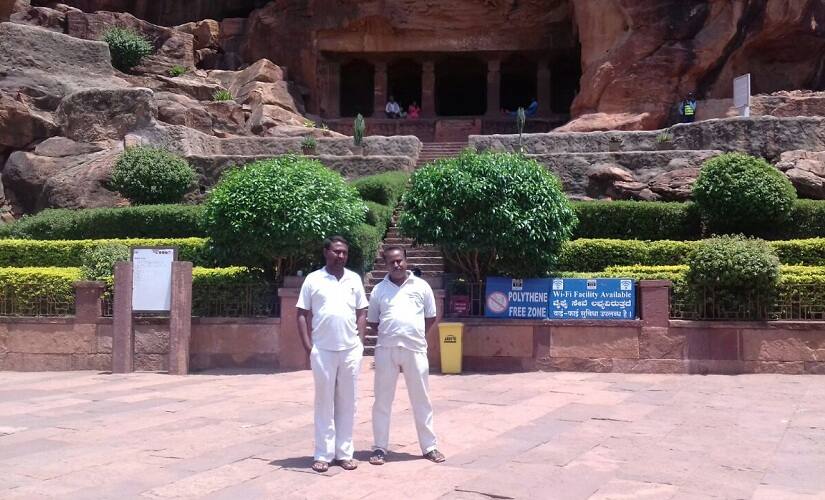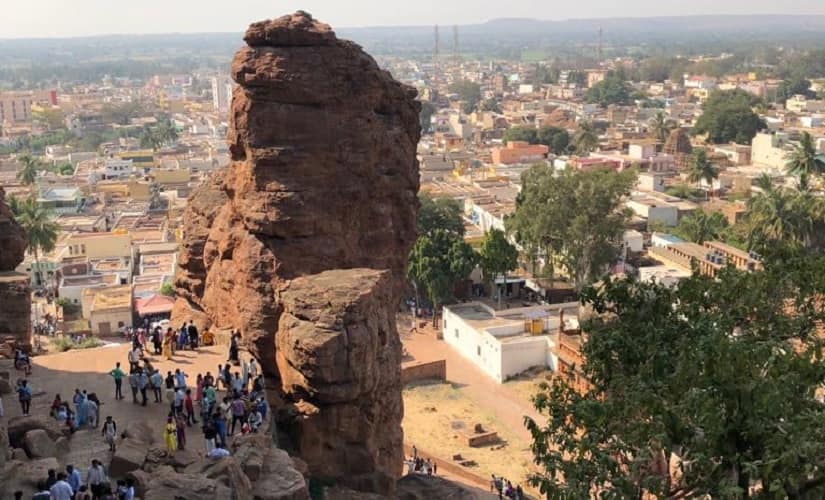Bijapur, Karnataka: There is a sense of excitement in North Karnataka’s historic Badami constituency. Notwithstanding that the sleepy region has been deprived of normal rains for many years, the youth is struggling as avenues for employment are limited, and the potential of the tourism industry hasn’t been exploited enough. Although the outgoing MLA from this constituency, Chimmanakatti Balappa Bhimappa, who had also won two consecutive terms in 1994 and 1999, is from the Congress, Chief Minister Siddaramaiah’s standing for the upcoming polls from this seat is being looked at as a ray of hope. The fielding of MP B Sriramulu from the Bharatiya Janata Party (BJP) makes this a battle between heavyweights. While winning the constituency is a matter of prestige for both, people are hopeful of some development coming their way. Badami was the capital of the Chalukya empire. The Chalukyas emerged from Badami and are part of Karnataka lore. The place is known for its Chalukyan style of temple architecture that evolved between the fifth and eighth Centuries. It was also the seat of power of the Chalukyas, who were considered valorous in battle — something that matched their temple-building activity. The cave temples of Badami are now part of the Badami-Aihole-Pattadakal tourist triangle. [caption id=“attachment_4453353” align=“alignnone” width=“825” class=“noalign”] Badami Railway Station. Firstpost/Tamanna Naseer[/caption] Centre’s HRIDAY failure The Union Ministry of Urban Development had launched Heritage City Development and Augmentation Yojana (HRIDAY) in January 2015 to preserve the character of 12 heritage cities, including Badami, to attract tourists. The scheme was supposed to focus on planning, development, implementation and management of policies to ensure sustainable growth of selected heritage cities in partnership with state governments. While the deadline for the completion of the scheme is November 2018, a cursory glance around Badami caves is enough to understand that work has not been done to “revitalise the soul of the heritage city, to reflect the city’s unique character by encouraging aesthetically appealing, accessible, informative and secured environment” as had been promised. According to data submitted in the Lok Sabha in July 2017, a Rs 19.18-crore fund was sanctioned for Badami — of which Rs 4.04 crore was released. However, the fund remains unutilised. There are 15 guides for the Badami caves and 11 of them are well-versed in Hindi and English. They charge Rs 500 for showing the entire complex. Prasanna Mugali, a guide working in Badami for the past 15 years, says, “From October to January, we see around 15,000 people, including groups from schools and foreigners, visiting the caves daily. The rest of the time we don’t have any job to do, the footfall is very low. The government doesn’t pay us stipends. Tourists are our only source of income.” [caption id=“attachment_4453359” align=“alignnone” width=“825”]
 Tourist guides await customers outside Badami Caves. Firstpost/Tamanna Naseer[/caption] The tourism plaza project around Pattadakal — a complex of seventh and eighth Century Hindu and Jain temples created under the Chalukya dynasty — didn’t materialise either as the state government failed to relocate the residential colony adjacent to the complex. The residents complain that the government wants them to shift three kilometres away from the city, while they are demanding monetary compensation and a space within the city. Istaling Sirsi, a social activist with a local cultural organisation named Vishwachetan Trust, says the tourism complex would have created employment opportunities for 2,000 to 3,000 people. But he hopes the chief minister gets elected. “If the chief minister gets elected, we want him to announce a special package to boost tourism of this region, like Mahamasthakabhisheka at Shravanabelagola." Interestingly, Sriramulu was the tourism minister in the previous BJP government in the state. While the saffron party’s Mahagundappa Kallappa Pattanshetti represented the constituency in both 2004 and 2008, some voters insist Sriramulu neglected the region during his tenure as a minister. [caption id=“attachment_4453367” align=“alignnone” width=“825”]
Tourist guides await customers outside Badami Caves. Firstpost/Tamanna Naseer[/caption] The tourism plaza project around Pattadakal — a complex of seventh and eighth Century Hindu and Jain temples created under the Chalukya dynasty — didn’t materialise either as the state government failed to relocate the residential colony adjacent to the complex. The residents complain that the government wants them to shift three kilometres away from the city, while they are demanding monetary compensation and a space within the city. Istaling Sirsi, a social activist with a local cultural organisation named Vishwachetan Trust, says the tourism complex would have created employment opportunities for 2,000 to 3,000 people. But he hopes the chief minister gets elected. “If the chief minister gets elected, we want him to announce a special package to boost tourism of this region, like Mahamasthakabhisheka at Shravanabelagola." Interestingly, Sriramulu was the tourism minister in the previous BJP government in the state. While the saffron party’s Mahagundappa Kallappa Pattanshetti represented the constituency in both 2004 and 2008, some voters insist Sriramulu neglected the region during his tenure as a minister. [caption id=“attachment_4453367” align=“alignnone” width=“825”] Badami viewed from its world-renowned monolithic caves. Firstpost/Tamanna Naseer[/caption] Water woes of Badami Water is an issue too. “There are 175 borewells in the city. But, only 70 to 80 are usable, the rest have dried up,” says Shankar KP, a middle-aged voter from the constituency. As the area is drought-hit, borewells are the main source for agriculture and drinking water. The Malaprabha canal systems cater to the irrigation needs in parts of Badami, but the maintenance work for the canal systems has not been done properly. If the Mahadayi dispute with the Goa government is resolved, Karnataka will be able to divert water from tributaries of the river, through the Kalasa-Banduri Nala project, towards the parched Malaprabha river basin. The implementation of the project could majorly solve the drinking water crisis of Badami residents. Voters, especially farmers are hopeful that all the attention the chief minister’s seat has received will help in resolving drinking water and irrigation issues. No fear of being deserted
Badami viewed from its world-renowned monolithic caves. Firstpost/Tamanna Naseer[/caption] Water woes of Badami Water is an issue too. “There are 175 borewells in the city. But, only 70 to 80 are usable, the rest have dried up,” says Shankar KP, a middle-aged voter from the constituency. As the area is drought-hit, borewells are the main source for agriculture and drinking water. The Malaprabha canal systems cater to the irrigation needs in parts of Badami, but the maintenance work for the canal systems has not been done properly. If the Mahadayi dispute with the Goa government is resolved, Karnataka will be able to divert water from tributaries of the river, through the Kalasa-Banduri Nala project, towards the parched Malaprabha river basin. The implementation of the project could majorly solve the drinking water crisis of Badami residents. Voters, especially farmers are hopeful that all the attention the chief minister’s seat has received will help in resolving drinking water and irrigation issues. No fear of being deserted
Although the electorate is glad there are two big candidates to choose from, a section of the voters expressed disappointment that both national parties had fielded “outsiders”. The Janata Dal (Secular) candidate Hanumantha Mavinmarad is a local resident, but he has not been able to cash in on the “insiders versus outsiders” dilemma of voters.
As both Siddaramaiah and Sriramulu are contesting from two constituencies, there is a probability of reelection in Badami, if one of them wins both seats and decides to desert this constituency later. It does not seem to bother the voters much though. Shankar says, “The chief minister said right after filing the nomination that he will make Badami the number one district in the state. Since he came here, at least he will see and understand our problems, and even if he chooses to leave Badami, he will look after us as chief minister.” Another cluster of villages in the constituency, Guledgudda, from where the JD(S) candidate hails, is home to many weavers. These handloom weavers are facing hardships due to competition from the power loom sector, marketing bottlenecks, infrastructural constraints, and rising yarn prices. They are waiting to list out their grievances when Siddaramaiah visits the constituency to campaign on 6 and 7 May. [caption id=“attachment_4453371” align=“alignnone” width=“825”] Former Union minister CM Ibrahim (extreme right) addresses party workers in Badami. Firstpost/Tamanna Naseer[/caption] The equations While the total number of voters in Badami is 2,12,187, Kurubas, Lingayats and Pancham Lingayats account for a large share of the electorate, followed by Ganigas, SCs, Valmikis, Muslims, Reddys and Lambanis. Although Siddaramaiah is from the shepherd community, the Kuruba votes alone will not give him the win. The Congress is eyeing the votes of Muslims as well as a section of the SC community. A battery of leaders, including SR Patil, BB Chimmanakatti, RB Timmapur, CM Ibrahim, and Valmiki leader Satish Jarkiholi, have been deployed to campaign in the constituency. The traditional party assumes that Siddaramaiah’s decision to contest in Badami will positively impact its performance in North Karnataka. BJP leader and former Karnataka minister Shobha Karandlaje has tweeted that Siddaramaiah has been misled:
A win is possible for Siddaramaiah only when the Lingayat votes get divided, BJP member Mahantesh Mamadapur says. “We could have given the ticket to a Lingayat. But we have also fielded an ST candidate who will get the support of the backward community,” he notes. The saffron party is relying on the votes of the Valmiki community, besides Lingayats, Veerashaivas, Reddys, Lambanis and the weavers. Prime Minister Narendra Modi is definitely popular among a section of the youth who are in awe of his working style, and the party will try to bank on it. The LPG connections given under the Pradhan Mantri Ujjwala Yojana were a hit among women voters. However, Congress leader Ibrahim says if Siddaramaiah wins, North Karnataka will naturally benefit. “Industrialists will come running here and people know it. In four years, Modi couldn’t create two lakh jobs. Let Modi and (Amit) Shah come to campaign, it will have zero effect.” The author is a Bijapur-based freelance writer and a member of 101reporters.com, a pan-India network of grassroots reporters


)
)
)
)
)
)
)
)
)



